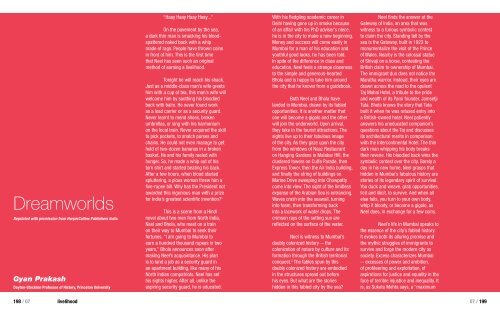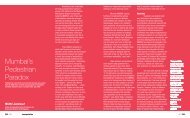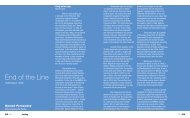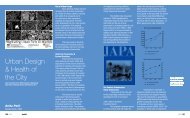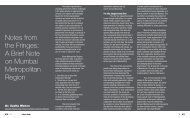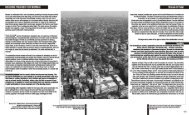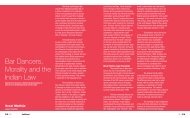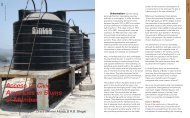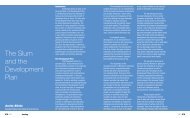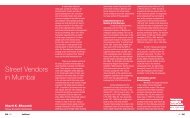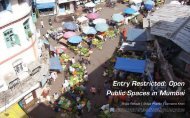Create successful ePaper yourself
Turn your PDF publications into a flip-book with our unique Google optimized e-Paper software.
<strong>Dreamworlds</strong>Reprinted with permission from HarperCollins Publishers India.<strong>Gyan</strong> <strong>Prakash</strong>Dayton-Stockton Professor of History, Princeton University“Haay Haay Haay Haay...”On the pavement by the sea,a dark thin man is smacking his bloodspatterednaked back with a whipmade of rags. People have thrown coinsin front of him. This is the first timethat Neel has seen such an originalmethod of earning a livelihood.Tonight he will reach his shack.Just as a middle-class man’s wife greetshim with a cup of tea, this man’s wife willwelcome him by soothing his bloodiedback with balm. He never found workas a load carrier or as a security guard.Never learnt to mend shoes, brokenumbrellas, or sing with his harmoniumon the local train. Never acquired the skillto pick pockets, to snatch purses andchains. He could not even manage to gethold of two-dozen bananas in a brokenbasket. He and his family reeled withhunger. So, he made a whip out of historn shirt and started beating his back.After a few hours, when blood startedspluttering, a pious woman threw him afive-rupee bill. Why has the President notawarded this ingenious man with a prizefor India’s greatest scientific invention? 1This is a scene from a Hindinovel about two men from North India,Neel and Bhola, who meet on a trainon their way to Mumbai to seek theirfortunes. “I am going to Mumbai toearn a hundred thousand rupees in twoyears,” Bhola announces soon aftermaking Neel’s acquaintance. His planis to land a job as a security guard inan apartment building, like many of hisNorth Indian compatriots. Neel has sethis sights higher. After all, unlike theaspiring security guard, he is educated.With his fledgling academic career inDelhi having gone up in smoke becauseof an affair with his PhD adviser’s niece,he is in the city to make a new beginning.Money and success will come easily inMumbai for a man of his education andyouthful good looks, he has been told.In spite of the difference in class andeducation, Neel feels a strange closenessto the simple and generous-heartedBhola and is happy to take him aroundthe city that he knows from a guidebook.Both Neel and Bhola havelanded in Mumbai, drawn by its fabledopportunities. It is another matter thatone will become a gigolo and the otherwill join the underworld. Upon arrival,they take in the tourist attractions. Thesights live up to their fabulous imageof the city. As they gaze upon the cityfrom the windows of Naaz Restauranton Hanging Gardens in Malabar Hill, theclustered towers on Cuffe Parade, thenExpress Tower, then the Air India building,and finally the string of buildings onMarine Drive sweeping into Chowpattycome into view. The sight of the limitlessexpanse of the Arabian Sea is entrancing.Waves crash into the seawall, turninginto foam, then transforming backinto a lacework of water drops. Thecrimson rays of the setting sun arereflected on the surface of the water.Neel is witness to Mumbai’sdoubly colonized history -- thecolonization of nature by culture and itsformation through the British territorialconquest. 2 The fables spun by thisdoubly colonized history are embodiedin the structures spread out beforehis eyes. But what are the storieshidden in this fabled city by the sea?Neel finds the answer at theGateway of India, an area that waswitness to a furious symbolic contestto claim the city. Standing tall by thesea is the Gateway, built in 1923 tomonumentalize the visit of the Princeof Wales. Nearby is the colossal statueof Shivaji on a horse, contesting theBritish claim to ownership of Mumbai.The immigrant duo does not notice theMaratha warrior. Instead, their eyes aredrawn across the road to the opulentTaj Mahal Hotel, a tribute to the prideand wealth of its Parsi founder, JamsetjiTata. Bhola knows the story that Tatabuilt it when he was refused entry intoa British-owned hotel. Neel patientlyanswers his uneducated companion’squestions about the Taj and discussesits architectural merits in comparisonwith the Intercontinental Hotel. The thindark man whipping his body breakstheir reverie. His bloodied back wins thesymbolic contest over the city. Barely aday in his new home, Neel grasps thathidden in Mumbai’s fabulous history arestories of its legendary spirit of survival.You duck and weave, grab opportunities,licit and illicit, to survive. And when allelse fails, you turn to your own body,whip it bloody, or become a gigolo, asNeel does, in exchange for a few coins.Neel’s life in Mumbai speaks tothe essence of the city’s fabled history.It evokes both its alluring promise andthe mythic struggles of immigrants tosurvive and forge the modern city associety. Excess characterizes Mumbai-- excesses of power and ambition,of profiteering and exploitation, ofaspirations for justice and equality in theface of terrible injustice and inequality. Itis, as Suketu Mehta says, a “maximum198 / 07 livelihood07 / 199
city.” How could it not be? Consider itsforging as a thriving metropolis out ofseven islets. Power, ambition, fantasy,and violence -- all had to be enlisted onan extraordinary scale. Its stories containa surfeit of dreams and nightmares, loftyaspirations of cosmopolitan opennessand violent nativist and communalpassions. These are what pulsateMumbai with energy and dynamism.Mumbai grows unabated,a megacity devouring mangroves,swallowing the graceful line ofbungalows, covering the landscape withapartment towers and shantytowns, andenveloping it all in its polluted air. Theinfrastructure creaks under the growingpopulation pressure. The city appearsout of control, its urbanism splintered bynativism and communalism. Where theaging Bal Thackeray and the Shiv Senahave lost some of their roar, Thackeray’snephew, Raj Thackeray, has picked upthe slack. His Maharashtra NavnirmanSamiti (MNS) has grown from strengthto strength, eating into the support of theShiv Sena from which he broke away. Acartoonist like his uncle, Raj Thackerayrides the tiger of populist politics bytargeting North Indian immigrants.These contemporary excesses producedespair and pronouncements of thecity’s death. But as Gillian Tindallreminds us, Mumbai’s problems aredue not to its weakness and declinebut to its strength and dynamism. 3 Thecity’s troubles mount because Mumbaicontinues to draw people by its promise.Vision MumbaiIf mounting problems producedespair, they also generate grand visions.A new vision for Mumbai appeared in2003. It was based on a study conductedby McKinsey and Company for BombayFirst, a nongovernmental organizationof business leaders. Carried out incooperation with the relevant governmentbodies, the study published a reportentitled Vision Mumbai: TransformingMumbai into a World-Class City. Theconsultants developed a databaseand framework for “benchmarkingMumbai” and for the “calibration”of its performance under differentparameters along a spectrum -- from“poor” to “average” to “above average”to “finally world class.” In McKinsey’sjudgment, the city’s slipping economicgrowth and quality of life placed it atthe lower end of the range on a numberof categories. Its recommendation? Achange in Mumbai’s “mind-set.” Insteadof the timid attempts at “incrementalimprovement and de-bottlenecking,”it advocated bold “step jumps.” 4The Maharashtra governmentpromptly succumbed to the seductivevision of Mumbai’s rise to “world-class”status. The chief minister appointeda task force composed of seniorgovernment officials and Bombay First’srepresentative, which endorsed the“world-class” aspiration. Enumeratingthe city’s woes, it painted a pictureof Mumbai hovering “perpetually onthe brink of collapse, with its swellingpopulation, deteriorating environment,income disparities and lack of funds.”The city risked “entering the graveyardof failed cities” unless it took commandof its future. Fortunately, there washope. It recommended seizing thepotential presented by globalization forincreased trade and “the transfer acrossgeographies of investment, technologyand talent” and proposed a ten-yearstrategic plan to improve governance,accelerate economic growth, constructaffordable housing, and developinfrastructure. If financed by a $40billion investment and fast-tracked by aseries of “quick wins” to secure publicsupport, the plan would turn Mumbaiinto a world-class city by 2013. “Theworld is watching. Mumbai is waiting.” 5Here it is once again, an enticingplanned vision of the future city. However,unlike the modernist twin-city project,this initiative comes not from architectsand urban planners but from businessleaders and a global consultancy firm.Echoing the ascendancy of the marketbasedideology, the proposal advocatesa “public-private” partnership, ratherthan a public undertaking. The marketorientation is particularly visible in itsproposals for private capital-based slumrehabilitation.Unfairly holding slumsresponsible for bottling up Mumbai’sgrowth, the document recommendsoffering builders incentives to constructtowers to house the slum dwellers.Particular attention is showered onDharavi -“Asia’s largest slum” -threesectors of which are to be cleared anddeveloped as office and commercialspace. With its proximity to the corporateBandra-Kurla complex, Dharavi is a realestate El Dorado, prompting attemptsto drive away slum dwellers. The citybeautiful can be built only by chasingaway the poor with the help of themarket, supplemented by evictions anddemolitions that miraculously follow theunveiling of “Vision Mumbai.” Severalcritics charge that the “world-classcity” is a dream sold to facilitate thecorporate takeover of the city’s future. 6The “Vision Mumbai” focus onhousing is no accident. Over sixty percentof Mumbai’s population lives in slums.The density of the city’s population is29,000 per square kilometer, the highestin the world -compared with 13,000in Shanghai, 10,000 in New York City,and 5,000 in London. Break it downfurther, and the figure for the densestMumbai ward climbs to over 100,000.The colonial state had resorted to theruse of a housing shortage to launch theBackbay reclamation, a ploy that wasused by the postcolonial governmentin the 1960s to push for further seizureof land from the sea. The aspiration tobecome a world-class city returned to thistried-and-tested tactic in proposing slumrehabilitation. Builders enthusiasticallyendorsed the move. Why would theynot? The Dharavi Rehabilitation Projectis a gold mine for them. As a newspapercomment points out: “Builders get535 acres of prime land, in return forproviding free housing to 52,000 families-plus hospitals, schools, internationalcraft villages, peace parks, art galleries,an experimental theatre and a cricketmuseum!”But since each “apartment”measures only 21 square meters, andthe minimum distance between twobuildings is only 5 meters, there willbe 1.8 million square meters that thebuilders may sell in the commercialmarket. Furthermore, the governmenthas granted an unprecedented floorspace index of 4.1 -- as opposed to thestandard 1.3 -- to attract developers.“No wonder the sharks can’t wait to bite.200 / 07 livelihood07 / 201
Luxurious 1,2 & 3 BHKFlats, By Meera Devidayal.Mixed media on can vas,40 x 30 in. Courtesy:Meera Devidayal.And with Rs 2,700 crore [$574 million]expected to land in the official kitty,neither can the state government.” 7CounterdreamsSince the start of the buildingboom of the early 1990s, the real estateindustry has aggressively sold the dreamof owning a home. Glossy brochuresand colorful advertisements promiserichly appointed apartments equippedwith the latest appliances and housed inexotically named residential complexesboasting lush green lawns and recreationfacilities. Meanwhile, the developersand the government entice displacedslum dwellers with offers of marginallylarger living spaces in modern towersequipped with plumbing and electricity.Urban activists have criticizedthe serious shortcomings of the privatecapital-led makeover dreams of thecity. A compelling critique also emergesin the works of Meera Devidayal, aMumbai artist. What is different about hercommentary is that it engages with thedream of a home at the level of its image.Devidayal began by collecting imagescirculated by newspapers and brochuresfrom property developers. People were“being bombarded with the marketing ofdreams by the media, by banks offeringeasy home loans, by developers offeringeverything from free vastu consultation[supposedly from the ancient science ofconstruction] to British governesses.” 8Her 2003 “Dream Home” exhibitionresponds to the fantasies spun by realestate entrepreneurs. In canvas aftercanvas, Devidayal brings into view therepressed desires of the dream home.Gold Valley presents a lifeless, graytenement building superimposed on alush green landscape that is watered bya stream. The fantasy of luxuriant nature,the “Way to Gold Valley,” as the sign readsat the bottom of the painting, crashesagainst the incongruous bleak reality ofthe square, cagelike tenement rooms.Through the windows, we see naturemapped as numbered property lots.Her Luxurious 1,2&3 BHKFlats is dominated by the image ofa blueprint of an apartment buildingelevation drawing. The bright red tulipsat the bottom suggest the dream homestored in the image. Running throughthe smooth surface and neat lines of theelevation is a brick crack, the trace ofa demolished structure. Together withthe antique lamp shade on the upperleft, the crack envisions or visualizeswhat is hidden by the blueprint, whatthe new will reduce to rubble.With an ingenioussuperimposition of architectural drawingover the painted surface of the canvas,Devidayal suggests the complicityof architecture in the destruction oflife’s rich texture. Unmindful of theconcrete experience of home, thereal estate industry forges aheadby reducing it to the abstract spacerepresented by geometric lines.But are the experience andmeaning of home in an immigrant city likeMumbai reducible to owning a dwelling?Feeling at home in the impersonalmetropolis is always a challenge. This iseven more so for immigrants in Mumbai.Because of their precarious livelihood inthe city, they have traditionally maintainedties with their native places. Mumbaiis just a mahanagari, a metropolis thatpoor immigrants endure to earn a living.They may live two or three generations inslums, but home is still the village or thesmall town they came from. Belongingis a complex emotion for those whostruggle to survive amid daily injustices.Muzaffar Ali’s 1978 Hindi filmGaman (Departure) offers a hauntingperspective on the meaning of home forimmigrant taxi drivers in Mumbai. We seethe city from the point of view of Ghulam,a Muslim who leaves his North Indianvillage after the family is cheated out ofits land by the landlord. Leaving behindhis ailing mother and wife, he lands atthe door of Lallu, a taxi driver, who ishis friend from the village. Lallu warmlywelcomes Ghulam, offers him some spacein his shack, and then takes him on a rideto the city’s tourist attractions. Much likeNeel and Bhola, they go to the Gateway,the Taj, and other sights. When Ghulamexpresses his awe at Bombay’s grandeur,his friend remarks that it is grand outsidebut rotten inside. We are warned thatthings are not what they seem in thecity. Sure enough, when the suburbantrain suddenly stops because someonehas died under the tracks, a passengerremarks: “Why did he die under thetrain? The delay is costing me money!Just drag the carcass out. Why wastetime?” When Ghulam expresses shock atthis indifference, his friend says: “Give ittime, you will also become indifferent.”Ghulam does not becomeindifferent, but we see an impersonalcity emerge through his eyes. Taxidrivers eke out a miserable living andsuffer humiliations inflicted by haughtypassengers and heavy-handed policemen.Lallu’s girlfriend’s old father, who drovea taxi for thirty years, is now addicted togasoline fumes. Shots of Marine Driveand Cuffe Parade seen through the taxiwindow are contrasted with the squalidshantytown in which the cab drivers live.But unlike the superficial and uncaringmilieu of the rich, depicted through theconversations of passengers, there ishumanity and solidarity in the world oftaxi drivers. Lallu not only shares hisshack with his friend but also gets himjobs, first as a taxi cleaner and thenas a driver. He is Hindu, and Ghulamis Muslim. But religion does not standbetween their friendship. Their world iscosmopolitan. Underlying it is not somedeveloped philosophy of cosmopolitanismbut a bond formed by village links andthe experience of struggling to survivein the stone-hearted city. Gaman shares202 / 07 livelihood07 / 203
Altamount Road, by MeeraDevidayal. Digital print,oil, enamel, and epoxygalvanized steel sheet,49 x 36 in. Courtesy:Meera Devidayal.The portrayal of a resourcefuland distinctive style of everyday, popularurbanism can be discerned in Devidayal’spaintings. The world she presents inher Where I Live series is far removedfrom that of the architect and the urbanplanner. Once again, the theme is adream home, and her subjects are poorimmigrants. She does not romanticizethem; nor does she share the reformer’sresponse of recoil and outrage at thesight of their abysmally cramped anddesperate living conditions. Devidayal’sart represents not “slums” but homes.Devidayal’s compassionateengagement with the imagination ofpoor migrants, with people living onthe edges of survival, is evident in thevery medium of her art in Where I Live.Consisting of digitally printed photographson recycled sheets of galvanized steel,her art incorporates the material oftheir lived lives, of huts fabricated withused, cast-off objects. The mediumcaptures the “everyday alchemies ofBombay’s informal sector” that “turndross into gold, giving a second life to thebroken and redundant objects of dailyuse.” 10 She counteracts the coldnessof steel by splashing its surface withcolor. The result is a work that not onlypays tribute to the survival strategiesof the poor by using recycled steel butalso attributes them with richness anddynamism. Thus, in Altamount Road thebright photograph of a film star, affixedon a steel almirah, in striking contrastto the gray corrugated sheet, offers acheerful portrayal of the poor’s patchedtogetherhome. The reflected imagesof the television, the utensils stackedon top and beside the almirah, add acolorful dimension. Devidayal does notromanticize the life of the poor. Her useof different surfaces and the spotlighton dissimilar objects draw attention tothe jagged world assembled by the poorwhile also recognizing their creativityand desires. The portrait that emerges isof an urbanism that turns necessity intoopportunity, an imagination that squeezescolor and pleasure from the gray anddreary conditions of the poor in Mumbai.Everyday Tactics of SurvivalThe clichéd description ofDharavi as “Asia’s largest slum” depictsthe 175-hectare tract, housing eighthundred thousand people, as a place ofmisery and oppression. In the corporateand middle-class visions of Dharavi,it is an obstacle in Mumbai’s path toachieving a “world-class” status. It isfor this reason that many critics in Indiaaccuse the Oscar-winning film SlumdogMillionaire of portraying Mumbai ina bad light. For them, the film is onemore example of the West’s obsessionwith poverty and wretchedness whenit comes to representing India. In fact,the critics share with the film the visionof Dharavi as an abject slum, ratherthan a place where the poor live andwork with imagination and enterprise.Prior to the late nineteenthcentury, Dharavi was a swamp inhabitedby the Koli fishing community. Fishingdied out as the swamp was filled. Poormigrants moved in from different partsof India, making the land habitable. Theirresourcefulness transformed Dharavi intoa flourishing economy. The eighteen-yearoldShamsuddin, for example, traveledall the way from Tamil Nadu to Dharaviin 1948, looking for work. 11 He workedinitially in his uncle’s rice-smugglingbusiness, transporting the grain from theoutskirts to the city to sell it at nearly tentimes the original price. The rice businessended after a few years when his unclemoved back to the village and the cousinsmigrated to Pakistan. Shamsuddinsurvived by working first for a coalcompany and then at a printing press. Hegot married, and the couple moved intoa ten-by-ten room in a “settled chawl”in 1961. A little later, Hamid, a man fromhis native village, arrived in Dharavi andmade him a proposition. “Give me spaceand I’ll make chiki [sesame brittle].”Shamsuddin procured him a shack andwent from shop to shop selling chiki andother snacks. When Hamid moved awayto Calcutta, Shamsuddin and his wifetook over the business. They learned howto make chiki, which he sold in cinemasevery day, returning home late at night.They packaged it and named their product“A-1 ckiki.” It grew into a successfulbusiness employing twenty workers, wholived in the two-room chiki factory’s loft.Shamsuddin’s story is notexceptional. Dharavi is full of suchtales of migrants making a go of theirlives. Their ingenuity and spirit havetransformed Dharavi into a thrivingeconomy amid poverty and squalor.Seen through the jaundiced eyes ofthe middle-class reformer the city isfull of only claustrophobic density, fetiddrains, garbage, and ugliness. But ifyou open yourself to observing thedrive, the enterprise, and the spirit ofsurvival amid the incredibly wretchedphysical conditions, you cannot helpbut be uplifted. Rarely do you seeidleness and despair associated withthis “slum.” From the establishmentsmanufacturing leather goods for exportand selling knockoffs of designerbrands on the main street to artisanalestablishments in the tight inner lanes,the picture is one of pulsating energy.Recycling is a way of life and livelihood.Dharavi is an economic successstory. It has developed without any publicstate subsidy or assistance. Illegalitythrives and is visible. Until police pressurechased him out to Tamilnadu in the mid-1980s, the notorious underworld donVardarajan Mudaliar used to distill anddistribute illicit liquor from his operatingbase in Dharavi. Today, although all kindsof illegal activities are openly carried outin the area, it is not infested with crimeand violence, as the popular middle-class206 / 07 livelihood07 / 207
Free enterprise in Dharavistereotype insinuates. Rather, Dharaviis a zone of booming free enterpriseand a tribute to the ingenuity and hardwork of the migrants, who come fromeverywhere in India. Tanners from TamilNadu, leatherworkers and artisans fromUttar Pradesh, potters from Gujarat, andmigrants from Maharashtra, Rajasthan,Bihar, and elsewhere work in Dharavi’samazing variety of trades, legal andillegal. Every religion is represented.Hindus, Muslims, and Christians coexistdespite bouts of communal violence.Every linguistic group is present, but thelanguage on the street is the mongreltongue Bambaiya. A mix of all the regionsfrom which people come, Dharavi is“allah ka gaon [God’s village],” saysKhatija, the old Muslim woman whomigrated from Kerala decades ago. <strong>12</strong> Itis a cosmopolitan mix brought togetherby dhandha -- business deals, cleanand shady. Dharavi is pure Mumbai.“No master plan, urban design,zoning ordinance, construction law orexpert knowledge can claim any stakein the prosperity of Dharavi.” 13 Thoughfar from perfect, it represents a form ofurbanism characteristic of what architectRahul Mehrotra calls the “kinetic city.”He distinguishes the kinetic city fromthe static city, which is composed ofarchitecture and monuments built withpermanent materials. The kinetic cityrepresents the city of motion -- “thekutcha city, built of temporary material”;it is temporal, a city in “constant flux.” 14In the apparent chaos of narrow streetscrowded with people disgorged bysuburban trains, in the constant makingand remaking out of recycled materials inDharavi, in the vital pulsating energy ofthe informal economy, in the exuberanceand spectacle of wedding processionson the street, and in the multiple usesof space, he finds a dynamic urbanism.The vibrant urbanism of the kutchacity shares urban space with the staticurbanism of the “pucca” (permanent,stable) city, colliding with it, provoking itswrath. The slum rehabilitation projectsrepresent attempts to displace the kineticcity, to expunge its existence, and toorder Mumbai to the dull discipline ofthe static city -- to the delight of realestate magnates and the middle-classheritage activists. Fortunately, the kineticcity survives in Dharavi; Mumbai’slegendary everyday tactic of survivalwith wit and enterprise stubbornlypersists under the looming shadow ofthe bulldozers of “development.”The Layered CityMehrotra’s “kinetic city” is a cityof layers, with multiple and successivehistorical slices of Mumbai coexisting inthe same time and space. Henri Lefebvrewrote that urban space has a structuremore like that of “flaky pastry” thanlike the homogeneous and isotropicspace of classical mathematics. 15 This istrue as much of the so-called boundedplaces of the cities of an earlier time asit is of the new urban constellations ofshopping malls and the displaced poor.You can get a vivid sense of thislayered history in Chor Bazaar (Thieves’Market), the city’s flea market. The placehas intrigued me from the very first time Iset eyes on it a few years ago. Since then,I have returned several times to the densemaze of shops that are located betweenSardar Patel Road and Grant Road. Asyou traverse the narrow lanes packedtight with vendors and stores selling abewildering array of goods -- genuineantiques and knockoffs, old coins,furniture, hardware, automotive parts,records, Hollywood and Bollywood filmposters and lobby cards, shoes, clothes,and just plain junk -- it becomes clearthat this is no ordinary flea market. Anextraordinary history is on display here.The objects on sale and thepeople who sell them embody the heritageof Mumbai’s urban life. Yes, it is a market,but the trade in the debris of commoditiesof modern life here tells stories about thecity. To make sense of these narratives,I had to begin with the name.“Let me tell you how ChorBazaar got its name,” said Zafar Bhai,the owner of Jubilee Decorators, a shopselling antique furniture and decorativeobjects in Mumbai’s legendary market.The owner of another furniture shopintroduced me to Zafar Bhai as an oldtimer,as someone who knows and haslived through Chor Bazaar’s history. Onelook at this man in his seventies withhis courtly manners, and you knew thatthere was something terribly odd andinappropriate about the bazaar’s name.The soft cadence of his elegant NorthIndian Hindustani language spoke ofa sophisticated urbanity, not devilishthievery. But he good-humouredlyaccepted Chor Bazaar as the name for themarket where he earns an honest living.“You see, the name goesback to the time when the Gateway ofIndia was built, when Queen Victoriavisited Bombay.” He continued witha tale about a theft. “When her shipdocked, she discovered that her violinwas missing.” It was the queen whoordered that the market be rechristenedChor Bazaar after the stolen violin wasfound on sale on Mutton Street. “Thisis how the place got its name.”Of course, Queen Victorianever set foot in Bombay. The Gatewaywas built to commemorate the visit ofthe Prince of Wales in 1911 and wascompleted only in 1924. I did not pointout these inaccuracies. To be sure, thestory is apocryphal, and yet it containsa representation of the past, one that isvery different from that which appearsin the archives. Like the bazaar, whichexists on the margins of the mainstreammarkets, this historical representation208 / 07 livelihood07 / 209
lurks outside the shadows of disciplinaryhistory. There are no documentaryrecords or commemorative plaquesto substantiate this expression of thepast; instead, it survives precariouslyin recycled stories as a faintimpression, imperfect and obscure.Enter the world of this past,and unexpected knowledge greets you.To begin with, let us take the colonialgenealogy of the name suggested bythe story. Flea markets are not unusual;all across the world one finds placesfor trade in the debris of modernity. Butto my knowledge, nowhere are theseplaces called Chor Bazaar. It is telling thatthis term was used in colonial cities toname sites for the trade in used goods.Delhi also had one with thisname. Such bazaars probably followedthe establishment of orderly marketswhere colonial subjects were expectedto act as modern bourgeois consumers.But when commodities sold in theorganized and official precincts are usedup, they lose the legitimacy conferred bythe shine of newness. Faded and wornout, when these artifacts returned fromthe dead to assume a second life asrecycled goods, they probably appearedas illegitimate. To the British, Chor Bazaarmust have seemed an appropriatename for a place where Indians (who,in any case, frequently appeared asuntrustworthy and dishonest in colonialstereotypes) bought goods to live stolenlives. It is no wonder, then, that ZafarBhai’s story pins responsibility on theBritish for the naming of the market.Chor Bazaar probably followedthe establishment of Crawford Marketand the founding of shopping arcadeson D. N. (Hornby) Road during thelate nineteenth century, when the cityexpanded beyond the Fort precincts. TheGazetteer, published in 1909, does notmention it, suggesting that the bazaaremerged only in the early decades ofthe twentieth century. By this time, thecotton mills had expanded, and the citywas flush with poor migrants who wereemployed as mill workers. Its locationin an area thoroughly revamped by theCity Improvement Trust during the 1910salso suggests that the market made itsappearance when Bombay became athriving industrial city. Bhai’s referencesto Queen Victoria (or the Prince of Wales)and the construction of the Gatewayof India also suggest the same.The apocryphal story, then,captures something of Mumbai’s colonialheritage as a modern industrial city. But itrefers to a heritage that is very differentfrom that monumentalized in the paradeof Gothic Revival buildings; rather thancommemorating the self-representationsof British power, it registers the colonialframing of the life cycle of commoditiesas they changed from their state ofglittering newness in shopping arcadesand established markets to their conditionas old, used debris in Chor Bazaar.Modernity and debris go handin hand. As commodity productionquickens the pace of life, it also hastensthe speed of obsolescence. Not only doesit label existing artifacts as traditionaland thus outmoded, it quickly rendersits own products out of date. Commodityproduction, aided by advertising,constantly strives to disseminate newstyles and fashions, casting awayyesterday’s goods as old-fashioned,as junk. You can find these outmodedcommodities in Chor Bazaar -- oldmariner’s compasses, cuckoo clocks, ArtDeco furniture and decorative objects, filmmemorabilia, and a baffling assortmentof other goods. Each object tells you astory of Mumbai’s urban life. Take, forexample, old jazz records, which you findfor sale in specialty stores. Besides tellingus about the change in the recordingtechnology and medium, the presence ofthese records in Chor Bazaar suggestsa decline in the appreciation of jazz inMumbai. Restaurants where jazz wasregular fare until the early seventieseither no longer exist or have moved on toother musical offerings.With the changein the social world that patronized jazz,the records too have moved on, endingup on the dusty shelves in Chor Bazaar.Look closely at the fusion music of Hindifilms and Latin beats, and you will findthe lost world of Goan musicians whowere in the forefront of Western musicin the city until the early seventies.Synthesizers and changes in musicaltaste in Hindi cinema have rendered thisearlier form of musical cosmopolitanismobsolete. Visit the store selling old filmmagazines, posters, lobby cards, andsongbooks, and you become aware ofan earlier technology of advertisement,now overtaken by television andcomputer graphics. The bazaar is a richarchive of such discarded histories.At first glance, the odd collectionof old artifacts in the bazaar appears asjust that -- odd. But if you examine itcarefully, you find that the arbitrarinessrepositions commodities; it tears themaway from their original historical contextand places them in a new environment.The unexpected juxtaposition of recordsand postcards, clocks and curios, postersand furniture, in the bazaar functionslike a montage, breaking up the smoothand evolutionary surface of historicalrepresentation.You see the city’s urbanheritage not in a linear fashion but in theheretical arrangement of fragmentaryand spatial combinations. Historyappears jagged and disjointed as youreyes move from old hardware parts tobeautiful objects sculpted in glass, fromjazz records of the sixties to knockoffsof Art Deco furniture fabricated today.The aura of heritage is broken by thearbitrary collection of commodities.Collectors of discardedhistory in Chor Bazaar210 / 07 livelihood07 / 211
If the ephemera on sale inChor Bazaar offer us a heretical archiveof Mumbai’s commodity life, they alsoprovide glimpses into changes in thefortunes of families. Goods end up herenot only when they become obsolete butalso when death and disputes break upfamilies. Chor Bazaar is the repository ofchanged and broken families. Interviewswith shop owners suggest that this wasparticularly the case during the 1940s andthe 1950s, when the Partition saw botha flight and an influx of people. Muslimfamilies who moved to Pakistan sold theirbelongings before seeking a new home inthe new country.The fact that most of theChor Bazaar merchants are Muslim mayhave eased these transactions. This wasalso the time when the outward trickle ofEuropeans began. If there was an outflowof people, there was also an inflow ofimmigrants, particularly the Sindhis,who made Mumbai their new home.Chor Bazaar became one ofthe places where these refugees boughtfurniture sold by departing Muslims.Thenext two decades witnessed the departureof Parsi families to the UK, Canada, andAustralia. Furniture dealers speak of thesedecades as Chor Bazaar’s golden age,when the market was flush with qualitygoods. Parsis, in particular, were valuedas sellers and buyers because of theirstrong preference for heavy, Victorianfurniture. Well preserved, the exquisitelymade Burma teak and rosewood furniture,designed in Victorian and modern styles,along with delicate, decorative objects,were bought from Parsis in estateauctions and household sales during thesixties and seventies. Apparently, thiswas when the market for used goodsmorphed into a bazaar for antiques.Antiques emerge onlywith modernity, when mechanicalreproduction deprives objects of theiroriginality and authenticity. Devoid ofany original essence and uniqueness,industrially produced goods acquirean aura only when they lose theirnovelty and are discarded. Then,what the city throws away as junkis recommmodified and assumes itssecond life as a residue of the past.As representations of adisappeared era, as condensedremainders of an elusive past, antiquesdo not have use value; they are valuedprecisely because they are useless. Noone actually uses these spittoons, clocks,picture postcards, and film posters.Even the delicate decorative furnishingsyou can buy at Bhai’s store are valuedas reminders of a bygone era and areused in film sets to evoke the past.The aura of antiques springsfrom their value as remembrances, asevocations of style. For this reason, too,one finds copies of antiques in plentifulsupply at the bazaar. Both owners andconsumers will tell you that there arevery few genuine antiques in ChorBazaar; for those you have to go toexpensive dealers elsewhere in the citywho can authenticate their collections.In the bazaar, you mostlyget knockoffs, which lack the aura ofuniqueness and genuine essence. Yet, thebazaar is always crowded with people.While some hunt for that rare thing thatthey cannot find anywhere else, otherseagerly acquire copies of antique furnitureand replicas of old gramophones. Theyare in the market for style. The city isan emporium of styles. While modernityhomogenizes urban life, standardizingindividuals and their environment, it alsocreates a strong desire for differentiation.Style provides one way to assertindividuality. The city is where you findthe dandy, who draws attention to hisperson through fashion, flamboyance,and wit. “In the old days,” said Bhai, “ahundred rupees bought you a good suit,shoes, and a tie; and with a little moremoney, you could throw in a bowler hat aswell, and there you were -- a proper cityman!” Today, one does not see dandieswith bowler hats in the city, but one findsMumbaikars furnishing their lives withboth genuine antiques and copies securedfrom Chor Bazaar. Surround yourselfwith an old gramophone, Victorian andArt Deco furnishings, film memorabilia,and jazz records, and you can rescueyourself from the modern jungle of urbananonymity and assert your uniqueness.Not for nothing, then, does ChorBazaar stand as the heretical heritage ofthe city. Existing in the shadows of themainstream markets and carrying an airof illegitimacy both in its name and in thegoods it transacts, the bazaar representsthe city’s history in junk, memorabilia,antiques, copies, and kitsch. There areno stories of a rise and fall, of glory anddecline, but only the debris of Mumbai’smodern life. You do not find historymemorialized and frozen in a museumhere. The remaindered past is alive, activein the present and exerting pressure onit by breathing life into what has beendiscarded as junk by history. [This essayis drawn from chapter 9 of my MumbaiFables (Delhi: Harper-Collins, 2010)].Notes1Surendra Verma, Do murdon ke liye guldasta [Bouquet for Two Corpses] (Delhi: Radhakrishna, 1998), 22. All translations are mine.2Ibid., 20.3Gillian Tindall, City of Gold (Delhi: Penguin Books, 1982), 3-4.4McKinsey and Company, Vision Mumbai: Transforming Mumbai into a World-Class City (Mumbai: Bombay First, 2003), vii.5Government of Maharashtra, Transforming Mumbai into a World-Class City: First Report ofthe Chief Minister’s Task Force (Mumbai: Government of Maharashtra, 2004).6Darshini Mahadevia and Harini Narayan, “Slumbay to Shanghai: Envisioning Renewal or Takeover?” in Inside the TransformingUrban Asia: Processes, Policies & Public Actions (New Delhi: Concept Publishing House, 2008), 94-131, particularly <strong>12</strong>1- 27.7Farah Baria, “A Pile of Dirt Worth Its Weight in Gold,” Sept. 24, 2006, http://www.indianexpress.com/news/a-pile-of-dirt-worth-its-weight-in-gold/13295/2 (accessed July 20, 2009).8Cited in Meher Pestonji’s catalog essay in Dream Home (Mumbai: Chemould Gallery, 2003).9Nancy Adjania, “Gaman/Aagaman: The Interstitial Spaces between Departure and Arrival,” inTum Kab Aaoge (exhibition catalog) (New Delhi: Anant Art Gallery, 2005).10Nancy Adjania, “Narrative Geographies: Meera Devidayal’s Map of Bombay,” WhereI Live (exhibition catalog) (Mumbai: Chemould Prescott Road, 2009).11Kalpana Sharma, Rediscovering Dharavi: Stories from Asia’s Largest Slum (Delhi: Penguin Books, 2000), 76-78. Sharma’ssensitive & insightful account demolishes the stereotypical image of the area as a miserable slum of squalor and crime.<strong>12</strong>Ibid., 36.13Matias Echanove and Rahul Srivastava, “Taking the Slum Out of ‘Slumdog,’” New York Times, February 21, 2009.14Rahul Mehrotra, “Learning from Mumbai,” Seminar 530 (October 2003).15Henri Lefebvre, The Production of Space, trans. Donald Nicholson-Smith (Oxford: Blackwell, 1991), 86.2<strong>12</strong> / 07 livelihood<strong>Gyan</strong> <strong>Prakash</strong> 07 / 213


